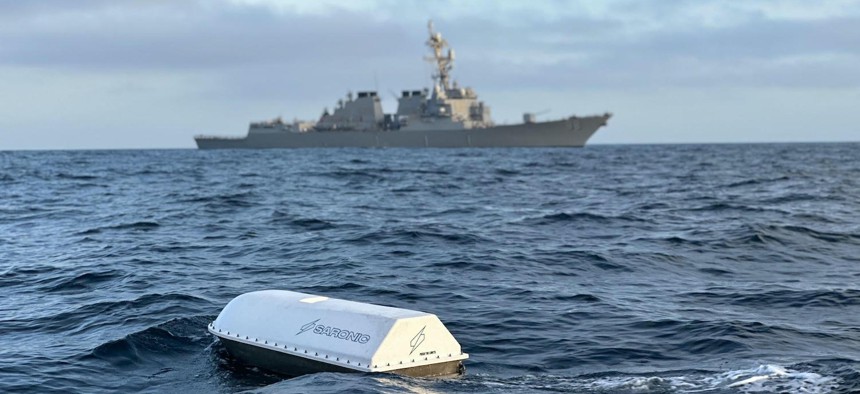
Courtesy / Saronic
Robot-ship startup raises $55m, sets sights on Replicator project
Two types of unmanned boats may become three, officials said.
Autonomous-surface-vessel startup Saronic has raised $55 million in its latest funding round that will allow the company to advance development of two types of uncrewed ships.
“What this fundraise allows us to do is accelerate development, invest in manufacturing and scalability of our platforms, and also invest in coastal testing, so that we're not just building the advanced technology, manufacturing the advanced technology at scale, but we're also testing five days a week so that we have the hardware reliability data that the Navy needs, but also the software autonomy, feeding back into our simulation environment that's constantly improving and adapting,” Saronic co-founder and CEO Dino Mavrookas said in an interview.
Rob Lehman, Saronic’s co-founder and chief commercial officer, added that the company would be pleased to participate in the Pentagon’s new Replicator project, which aims to quickly acquire thousands of drones.
The Series A funding round—that is, the round that follows initial seed funding—was led by Caffeinated Capital, with participation from 8VC, Andreessen Horowitz, Lightspeed Venture Partners, Point72 Ventures, Silent Ventures, Overmatch Ventures, Ensemble VC, Cubit Capital, and the U.S. Innovative Technology Fund.
Saronic has developed two autonomous surface vessels: Spyglass, which is fully electric and can carry a 40-pound payload for 30 nautical miles, and Cutlass, a 13-foot, diesel-electric hybrid that can carry a 200-pound payload for 300 nautical miles. The company is also developing a third ship, called Corsair.
The boats are being designed to operate without relying on GPS satellites, Mavrookas said.
Saronic plans to add ten employees to its 45-person workforce by month’s end to help increase its manufacturing capacity, he said.
“We've already built up the capacity, and personnel, and equipment, and facility space to produce hundreds of our vessels on an annual basis,” he said. “We can very easily, with advance-demand signals and private capital investments, scale that to thousands if need be.”
Saronic executives say that its unique, technology-first approach will allow it to build quickly if needed.
“We are the only company that comes into the market as a technology company that delivers capabilities through boats, right, everybody else's approached it from: boat company trying to adopt technology to deliver a capability,” Mavrookas said. “We've seen in other markets and industries, I've been trying to adopt advanced technology and autonomy to legacy hardware platforms, it really does fall apart.”
Autonomous vessels are expected to play a large role in the Navy of the future by conducting intelligence and other types of missions and allowing larger, more expensive crewed ships to stay further away from hostile seas. But to date, the Navy has only used these types of vessels in limited roles in the Persian Gulf.
Still, the Pentagon says it needs different types of drones, and lots of them, to counter China in the Pacific. In August, Deputy Defense Secretary Kathleen Hicks announced Replicator, an effort to create cheap drones across the air, sea, and land in the “multiple thousands” within the next two years.
“I think Replicator is a perfect example of how a company like Saronic and our technology can get into warfighters’ hands quickly and take advantage of things that are being developed at the pace of industry, not at the pace of the [Pentagon’s budget process],” co-founder Lehman said.
The same month, Saronic participated in a Navy exercise in San Diego.
“We were running full mission profiles with our Navy partners, launching and recovering off of Navy craft,” he said.
The company will be part of the Navy’s Integrated Battle Problem 24.1 exercise in March, with its Spyglass and Cutlass ships, Lehman said. Those trials will focus on unmanned surface vessels and multi-domain operations.




